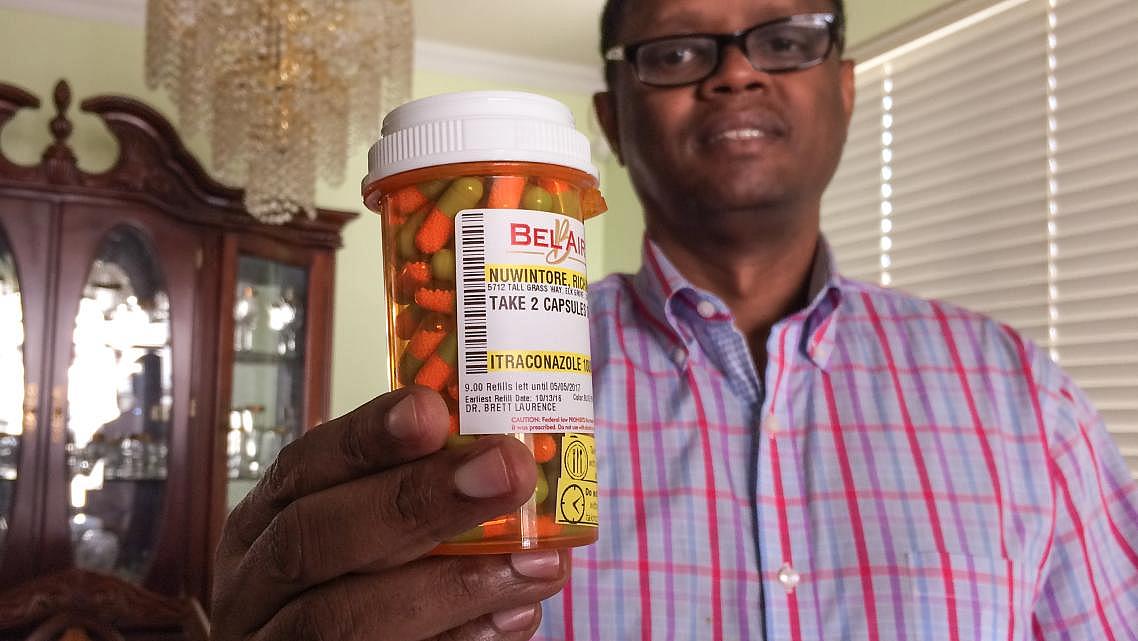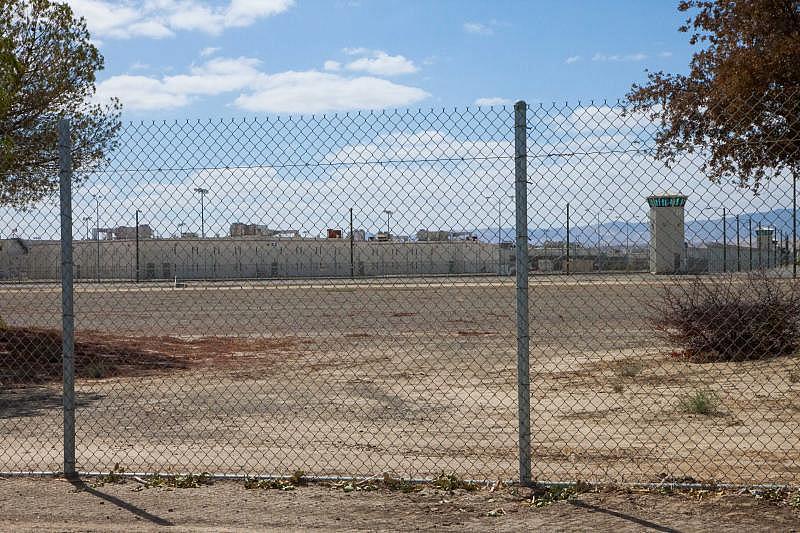California prisons reduce risk of valley fever for inmates

Five years after his diagnosis, Richard Nuwintore still swallows four pills a day of the potent antifungal itraconazole.
(Kerry Klein/Valley Public Radio)
Richard Nuwintore was barely three weeks into his sentence at Taft Correctional Institution when he began to cough and experience chest pain. Within a few days, it was obvious something was wrong.
“I could touch my skin and I was really hot,” Nuwintore said. “I had the coughing, the night sweat. My appetite was gone. I couldn't eat. I couldn't swallow, and I was losing weight really, really fast.”
A diagnosis arrived after X-rays and blood tests: valley fever, a fungal disease endemic to dusty areas of California and Arizona. Kern County, where Taft is located, has the highest rate of valley fever cases of any county in the California. Originally a refugee from the east African country of Burundi, Nuwintore had never heard of the disease before arriving at Taft.
“Other inmates were telling me about valley fever, and I was like, ‘What is it? What is it?’” he said. “It was something scary, you know?”
Nuwintore was a victim of climate, genetics and confinement. In 2011, when he was diagnosed, valley fever rates in Arizona and California were skyrocketing — a peak experts largely attribute to weather cycles of rain and drought. And research shows people of African-American or African descent, like Nuwintore, are more prone to the disease than Caucasians.
At that time, valley fever rates were particularly high within prisons in the Central Valley. State prisons there reported hundreds of cases and as many as nine deaths from valley fever every year. In the hardest hit prison in 2011, 7 percent of the inmates contracted the disease. Taft is a federal prison and its health data have not been made available.
In the last few years, state prisons, at least, have made changes. They have worked harder to screen out prisoners who are the most vulnerable to the disease and to take measures to lower the risk to inmates who are incarcerated there. Between 2011 and 2015, their valley fever rates fell dramatically — close to 90 percent overall. Within that time period, valley fever became less prevalent all around, but even in the most endemic areas of the southwest, background rates fell by only 30 to 50 percent.
Health impacts last beyond prison sentence
Nuwintore came to the U.S. as a refugee in 1992. In 2011, he began a 14-month prison sentence for credit card fraud. Now, he lives on a suburban cul-de-sac outside Sacramento with his mother and girlfriend.
Years after completing his sentence, Nuwintore’s time in prison remains in his system. Twice a day, he twists open a thick bottle of itraconazole, an antifungal medication that he’ll likely take for the rest of his life. The huge pink and blue pills keep him alive, but their side effects are almost as bad as valley fever itself.
“You wake up. You have a little bit of energy, but as the day goes by you start to just feel pain in the joints,” he said. “Of course, your stomach is still on fire because the medicine is kind of powerful. And fatigue, and sometimes you get dizzy.”
Nuwintore isn’t alone. In the last decade, over 3,500 state inmates have contracted valley fever while doing time. Many still struggle to manage the disease.
Prisons take steps to reduce risk
Those improvements in state prisons did not happen quickly or easily. In fact, it took outside intervention to bring the numbers down.
Beginning in 2006, the California Department of Corrections and Rehabilitation began excluding inmates with suppressed immune systems — due to factors like HIV or chemotherapy — from all eight prisons in the Central Valley. But valley fever rates still spiked.
More sweeping interventions arrived in 2013. That’s when a federal receiver appointed to oversee health care in state prisons mandated that individuals from the most at-risk ethnicities — African-Americans and Filipinos — be excluded from Avenal State Prison in Kings County and Pleasant Valley State Prison in Fresno County. Prior to that year, those two facilities each diagnosed hundreds more cases of valley fever annually than almost any other state prison.
“I think [valley fever] is one of the biggest issues that we've had in this system,” said Janet Mohle-Boetani, a health administrator with the California Department of Corrections and Rehabilitation. “We're taking precautions for every prison in the Central Valley, and we're taking extra special precautions for the two prisons that have the very high rates of valley fever.”
Those two prisons have also modified their landscaping to minimize dust, and they allow inmates to stay indoors when wind speeds are high. Inmates also are allowed to wear dust masks while they’re outside.
The biggest change arrived in 2015 on the recommendation of the Centers for Disease Control and Prevention. It’s a skin test called Spherusol that can detect valley fever immunity, and it’s offered to every inmate entering the state prison system. An individual who tests positive is immune.
“If they inhale the dust with the fungus in it and they've tested negative, they're much more likely to get the disease than someone who has a positive test,” said Mohle-Boetani. “So if someone comes into the reception center and then they test negative, we put a medical restriction on those patients so they are not sent to live in Avenal or Pleasant Valley State Prison.”
People gain immunity after successfully fighting off the disease — and because so many people are infected without developing symptoms, many people never know they had the disease. In a mass screening in early 2015, around 35,000 inmates in the California prison system took the test and 9 percent were shown to be immune.

Pleasant Valley State Prison in western Fresno County has reported the most cases of valley fever of any California state prison.
(Kerry Klein/Valley Public Radio)
The CDC recommended Spherusol to the state prison system shortly after the test became commercially available in 2014. The FDA has not actually approved of using the test for this purpose, but like other medical products, it can be used off-label.
“Given the fact that they were having such high rates of cocci, we knew that we needed to do whatever we could to try to help them lower the risk,” said Tom Chiller, chief of the Mycotic Diseases Branch at the CDC, referring to valley fever by its scientific nickname. “We immediately thought, maybe this could be used to understand which prisoners could exist in an area with the fungal spores but not get infected, or at least have an extremely low risk of getting infected.”
The CDC predicted Spherusol would prevent more valley fever cases than any other measure so far, but Chiller said it’s still too early to calculate the test’s precise impact. Sharing that opinion is Dr. John Galgiani, director of the University of Arizona’s Valley Fever Center for Excellence.
“I think they should be given credit for the drop to some extent, but it'll take time to see if it stays low to see if it's because of the policies that are now put in place,” Galgiani said.
Taft, a federal prison, is a slightly different story. According to a representative from MTC, the company that runs the privately operated prison, incoming inmates are provided with information about valley fever risk, but they are not offered a Spherusol test. The representative did not reveal if at-risk inmates are relocated to other facilities.
Richard Nuwintore may not have the energy to hold down a job, but he has been keeping busy. Earlier this year, he and another Taft inmate won a landmark court case that granted inmates who contract the disease in federal prison the right to sue the U.S. government. Lawsuits have been filed against the state prison system for years.
It’s one path of recourse for Californians who do their time and come out with a life sentence.
For more stories in this series, click here.

